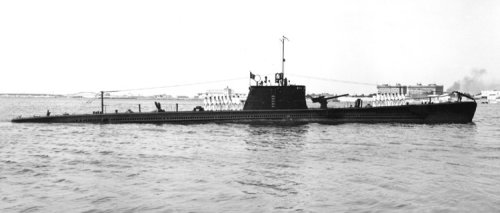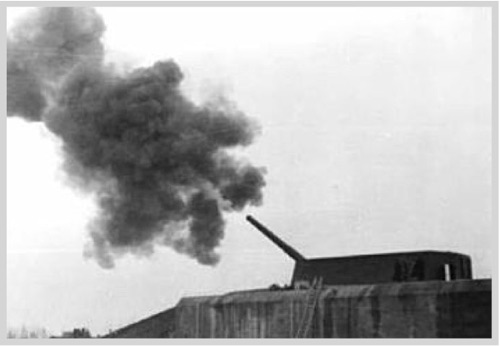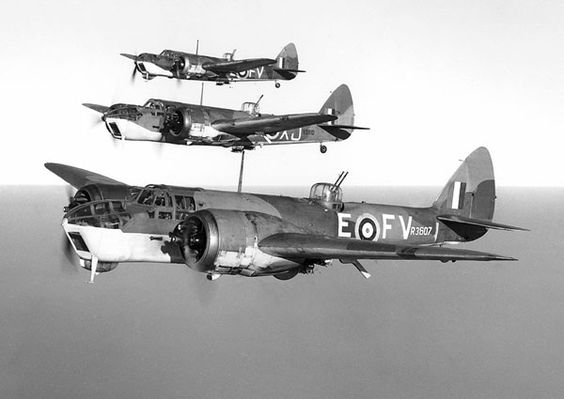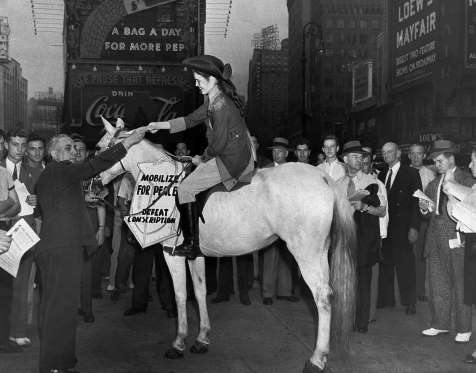Thursday 22 August 1940
The Germans already have shelled Dover itself with the guns on 18 August. Today, 22 August 1940, the Germans try attacking some ships which are in a coastal convoy ("Totem") near Dover. Opening fire at 09:00, they create quite a surprise for the British sailors, who suddenly see 100-foot waterspouts appearing nearby. The escort destroyers quickly make smoke, and the Germans make no hits with their big guns after firing for 80 minutes. The guns at this point include:
- The Siegfried Battery at Audinghen, south of Cap Gris Nez, with one 38 cm (15 in) gun;
- Four 28 cm (11 in) guns at Grosser Kurfürst Battery at Cap Gris Nez.
- Three 30.5 cm (12 in) guns at Friedrich August Battery, to the north of Boulogne-sur-Mer.
 |
| One of the main British guns (this is "Pooh") which responded to the German battery on Cap Gris Nez. |
 |
| The Pas de Calais gun firing. |
Just past noontime, the Luftwaffe follows up on the German guns firing in the Channel and attacks the same "Totem" convoy. RAF No. 54, 610 and 615 Squadrons rise to defend. They prevent the attack but lose a Spitfire of No. 54 Squadron (pilot G.R. Collett killed). In addition, there is a case of friendly fire, with one Hurricane of No. 615 Squadron shooting down another. The pilot lived, and you can bet there were words at supper later on.
In the early evening around 18:30, another raid comes across near Deal. It is a Freie Jagd or fighter mission without bombers. RAF Fighter Command has a practice of not challenging such missions forcefully, but they send up Squadron No. 616 (not a favored mission) anyway. Among the fighters is a large group of Bf 110s from EprGr 210 that heads for RAF Manston. The Bf 110s get through, drop thirty bombs on Manston, and destroy a couple of hangars and two Blenheim bombers. Not only is the airfield temporarily put out of action, but the intercepting fighters lose a Spitfire.
There are some other scattered attacks. RAF No. 302 (Polish) Squadron claims to have downed a couple of Junkers Ju 88 bombers. Special Luftwaffe unit KGr 100 attacks Bristol with 23 Heinkel He 211s flying out of Vannes, France just before midnight using its cutting edge electronic guidance system (X-Verfahren) that the RAF doesn't even know about yet. As usual, they attack the aircraft factories at Filton, which this time seriously damages the works. Best of all for the Luftwaffe, they don't lose any of the unique planes.
The day's most significant event, though, occurs in the early morning hours around 03:30. Bombs fall on Harrow and Wealdstone. Technically, they are not in London, but for all intents and purposes (and in the view of the Home Guard) they are indeed part of London. The sector is part of the London Civil Defence Area.
 |
| Damage outside the Military Police headquarters at Docks Gate, Millbay Docks, Plymouth. The area was hit by an incendiary bomb of the "oil" type. © IWM (A 261) |
HMS Peregrine sends off Swordfish torpedo bombers of RAF No. 812 Squadron to bomb the invasion barges gathered at Daedereide, the Netherlands. They lose one plane. Bomber Command sends off 52 bombers to various targets in Germany and 33 to bomb French targets, but the poor weather hampers their operations, too.
The day is a rare victory for the Luftwaffe, the first time that they lose fewer planes than the RAF in aerial combat (not counting losses on the ground. Most accounts give the totals as 4 losses for the Luftwaffe and 5 for the RAF. When you include the RAF losses on the ground and the fact that the Luftwaffe put RAF Manston out of operation, it was a very good day indeed for the Germans.
 |
| Damage to steamer Sir John Hawkins and the surrounding area of Millbay Docks, Plymouth on 22 August 1940. © IWM (A 259). |
The Luftwaffe awards the Ritterkreuz to:
- Theo Osterkamp, former commander of JG 51;
- Major Max Ibel, Kommodore of JG 27;
- Obstlt. Harry von Bülow-Bothkamp, Kommodore of JG 2 and a former Gruppenkommandeur of II./JG 77.
The Luftwaffe shifts JG 2, 27 and 53 from Cherbourg to Calais and transfers them from Luftflotte 3 to 2. Calais is a bit handier for operations against the Channel convoys, and the flight across is a bit shorter, giving British radar smaller lead-time to track interceptors to meet them. It also gives the fighters slightly more time over England and makes it more likely that damaged fighters can make it back to base. Finally, it also is handy to have more fighters nearby to protect the big artillery being put into service at Cap Gris Nez.
Battle of the Atlantic: U-37 () torpedoes and sinks Norwegian cargo ship Keret in the Atlantic. There are 7 survivors and 13 crew perish.
The Luftwaffe bombs and sinks Canadian cargo ship Thoroid in the South Irish Sea near Small's Lighthouse. There are 11 deaths.
Convoys OA 203 and MT 147 depart from Methil, Convoy FN 260 departs from Southend, Convoy FS 259 departs from the Tyne.
Convoy AP.1, part of Operation "Apology," departs the Clyde. This is a convoy of transports (converted liners: HMT Duchess of Bedford, Denbighshire, and Waiotira) headed to Suez, part of the continuing effort to reinforce British garrisons in the Middle East. They are transporting 3rd Hussars, 2d RTR and 7th RTR, including a number of tanks, artillery, and Hurricanes. The convoy is heavily defended and carries with it 150 tanks. This delivery is pursuant to the decision made earlier in August during discussions with Middle East commander General Wavell.
Corvette HMS Gloxinia (K 22, Lt. Commander Arthur J. C. Pomeroy) and sloop HMAS Warrego (L 73, Commander Ross V. Wheatley) are commissioned.
 |
| Damage to steamer Sir John Hawkins at Millbay Docks, Plymouth on 22 August 1940. © IWM (A 256). |
Force A (destroyers) and Force B (cruisers and destroyers) operating out of Alexandria depart to patrol around Gavdo Island. This is Operation MD 7.
At Malta, Governor Dobbie receives a telegram from the War Office listing supplies being sent to Malta around Africa and through the Suez Canal. They include three ships carrying:
- Ship 1: ammunition, 11 tractors, 2 3.7" antiaircraft guns, and 746 tons of supplies for the Royal Engineers;
- Ship 2: ammunition, 12 3.7" antiaircraft guns, 10 40mm Bofors guns, 70 tons for the Royal Engineers, and other supplies;
- Ship 3: ammunition, 11 tractors, 2 3.7" antiaircraft guns, and other supplies.
German Propaganda: While no decision to bomb London has been made by the Luftwaffe - actually, it must be ordered by Hitler personally - German radio threatens the destruction of London using "aerial torpedoes carrying many tons of high explosive and guided by radio." While not a completely nonsensical threat, such weapons are still in the very early development phase. It is quite odd that the propaganda service would reveal anything at all about their supposed existence. This shows the high importance placed by the Germans on psychological warfare.
 |
| Italian submarine Iride, sunk 22 August 1940. |
- 10,000 British troops;
- Numerous underground tunnels and galleries, more fortified than the Maginot Line;
- Enough food to last for 18 months;
- 19 RAF bombers, 13 reconnaissance planes, 34 fighters;
- numerous anti-aircraft guns.
Italian Government: Mussolini has his military command secretly preparing plans for the invasion of Greece, but he tells them to stop the planning for the time being.
US Government: James V. Forrestal becomes the Undersecretary of the Navy responsible for procurement.
British Government: Prime Minister Winston Churchill visits RAF Kenley in southern London, which has been badly damaged in recent Luftwaffe raids.
August 1940
August 1, 1940: Two RN Subs Lost
August 2, 1940: Operation Hurry
August 3, 1940: Italians Attack British Somaliland
August 4, 1940: Dueling Legends in the US
August 5, 1940: First Plan for Barbarossa
August 6, 1940: Wipe Out The RAF
August 7, 1940: Burning Oil Plants
August 8, 1940: True Start of Battle of Britain
August 9, 1940: Aufbau Ost
August 10, 1940: Romania Clamps Down On Jews
August 11, 1940: Huge Aerial Losses
August 12, 1940: Attacks on Radar
August 13, 1940: Adler Tag
August 14, 1940: Sir Henry's Mission
August 15, 1940: Luftwaffe's Black Thursday
August 16, 1940: Wolfpack Time
August 17, 1940: Blockade of Britain
August 18, 1940: The Hardest Day
August 19, 1940: Enter The Zero
August 20, 1940: So Much Owed By So Many
August 21, 1940: Anglo Saxon Incident
August 22, 1940: Hellfire Corner
August 23, 1940: Seaplanes Attack
August 24, 1940: Slippery Slope
August 25, 1940: RAF Bombs Berlin
August 26, 1940: Troops Moved for Barbarossa
August 27, 1940: Air Base in Iceland
August 28, 1940: Call Me Meyer
August 29, 1940: Schepke's Big Day
August 30, 1940: RAF's Bad Day
August 31, 1940: Texel Disaster
2020










